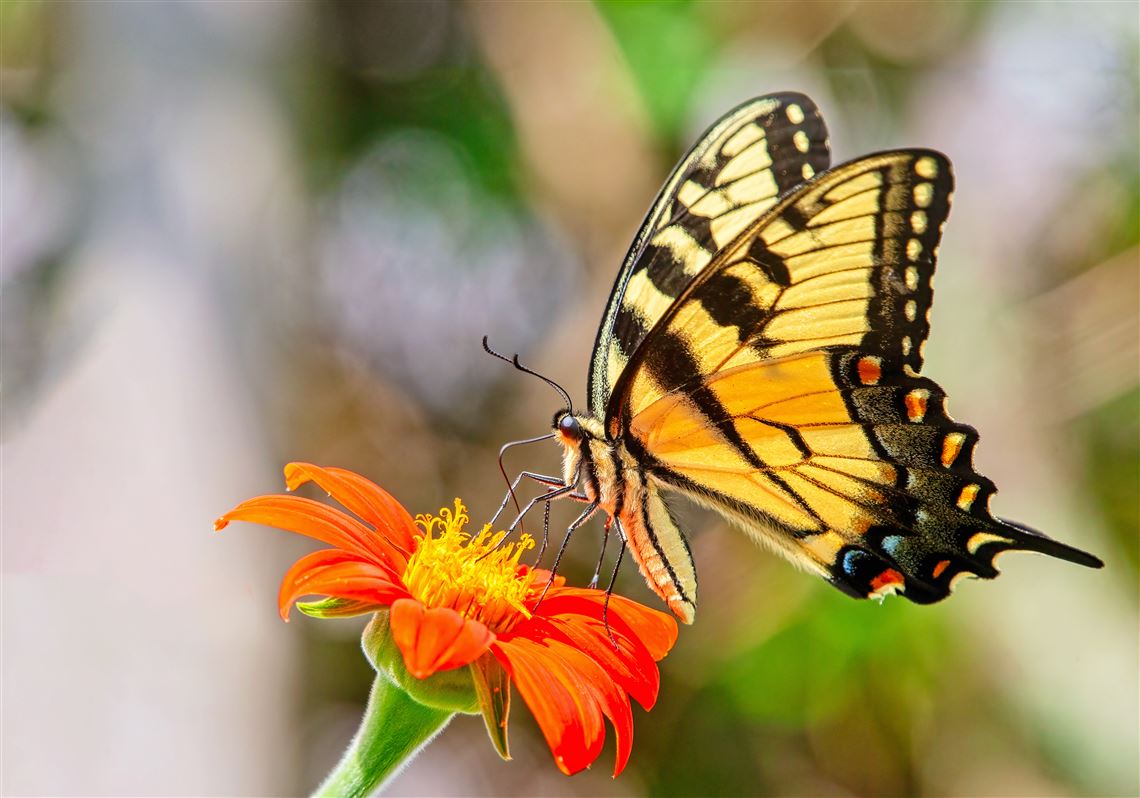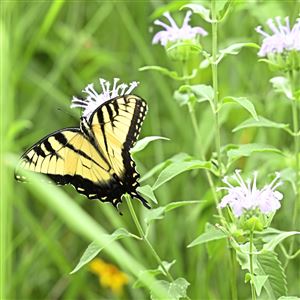The visual symphony of lepidoptera is a sublime sight, with about 2,500 species of butterflies and moths in the state.
In August and September, close to 1,600 lepidoptera species are typically observed in the state, comprised mostly of moths and 88 butterfly species, according to nonprofit naturalist community website iNaturalist.
By late summer, too many home gardens are forlorn and spent. That’s when the late native plant bloomers take the stage in full sun.
The soft pinks of joe-pye weed, waves of goldenrod, multiple hues of asters and black-eyed Susans fill uncut fields and special native plant gardens.
The stars of the show are the insects flitting about, drinking nectar and collecting pollen. And they’re not just pretty, they are productive.
Best places to see butterflies
A sampling of locations in the region from local experts
According to estimates published by the National Science Foundation, between $235 billion and $577 billion in annual global food production relies on pollinators, including butterflies.
Events, experiences and locations
Finding butterflies can be more intentional than happenstance; you just need to know when and where to look.
There’s the easy route: events such as the upcoming Monarch Butterfly Festival in Carnegie on Aug. 25 feature gardens, festivities and, of course, monarch butterflies. The National Wildlife Federation recognized the borough as a “Monarch Champion” for its conservation efforts for the declining butterfly in 2022.
The Pittsburgh Zoo & Aquarium’s “I Spy a Butterfly” experience is a new seasonal walk-through greenhouse teeming with special plantings and native butterflies. The exhibit continues through Sept. 2.
The Audubon Society of Western Pennsylvania offers programs and public access to butterflies and moths at its nature preserves.
Then there’s the more adventurous route.
Local experts picked the best places to see butterflies in Pittsburgh and surrounding counties including state parks, Allegheny County parks, Pittsburgh city parks and nature preserves. (See sidebar.)
Butterflies and pollinators frequent numerous parks and green spaces featuring special native plantings intended to attract and sustain them in a variety of state, county and city parks, and municipalities, said Melissa Reckner, manager of Penguin Court/Brandywine Conservancy in Laughlintown, Westmoreland.
Penguin Court, the grounds of the former Scaife estate, and the Southern Alleghenies Museum of Art are among some two dozen sites and organizations that make up Westmoreland Pollinator Partners, a group of non-profits, schools and community gardens dedicated to preserving pollinators and their habitats. All but two of those sites offer special native plant gardens or meadows that the public can view.
The museum will present “Monarchs, Milkweed and More” at Penguin Court on Aug. 25.
“Late summer is a good time to view the gardens because a lot of flowers are in bloom, and of course the beloved monarch butterfly typically starts its southern migration in late August,” Reckner said.
Westmoreland Pollinator Partners offers other events, such as mothing nights.
County hot spots for butterflies include the Winnie Palmer Nature Reserve, with its acres of native plantings receiving lots of full sunlight, Reckner said.
Best time and place to catch them
Cold blooded, butterflies need heat to be active — at least 75 degrees.
Look for them congregating and feeding in warm, sunny, calm areas, according to the Penn State Extension.
Most people gravitate to big butterflies: monarchs, Eastern tiger swallowtails, black swallowtails, spicebush swallowtails, pipevine swallowtails, red-spotted purples, viceroys and great spangled fritillaries, said Michael Skvarla, assistant research professor of arthropod identification at Penn State’s Department of Entomology.
“Adult butterflies out there now are generalists. It doesn’t matter so much what is in bloom,” he said. “Go to plants that have open accessible flowers.”
What you see in late summer and early fall is different than in spring, he noted.
“Swallowtails will peter out closer to fall and you will start to see more monarchs on migration as well as mourning cloaks that overwinter as adults,” Skvarla said.
The monarch population from central Mexico continues to drop, declining more than 80% since the 1990s due to loss of milkweed habitat, herbicide-resistant crops, pesticides and other factors, according to international nonprofit the Xerces Society.
“It seems the trend is not reversing itself. We’ll see,” he said.
The big butterflies are the most obvious, although they are less abundant, Skvarla said.
Don’t be afraid to think small. “You’re looking for an insect with a 1-inch wingspan instead of 4 inches,” he said.
But you will need binoculars or a net to inspect these tiny gems. Like birds, butterflies fly away when you get too close.
For adult watchers, they should use binoculars and stand at least 10 feet away from the insect, Skvarla advised.
If you have kids, take a butterfly net. “But do not sweep too hard to catch them,” he said.
“For kids, a little bit of handling is unlikely to damage them. It’s like snakes. If I’m by myself, I will just observe but if there are kids, I’ll grab the snake and show them.”
That is, if it’s non-venomous.
Find fields in flower
Butterfly magnets this time of year include blooming natives such as joe-pye weed, asters and goldenrod, said Chris Firestone, a botanist with the Pennsylvania Department of Conservation and Natural Resources.
These plant species are found in old meadows and uncut open fields or special gardens loaded with native plants, she said. In late summer and early fall, the proliferation of goldenrod and asters make for great honey for beekeepers, she added.
Don’t shy away from goldenrod; it doesn’t set off an allergy. The pollen from goldenrod is not wind-borne, she said.
However, a common companion plant, ragweed, is.
“Look along the roadsides and look at the other colors that are changing from green to other fall colors and the asters and the goldenrod are just adding to the colors,” she said.
Although the cultivar and easily available butterfly bush (not to be confused with the native butterfly weed) attracts butterflies and pollinators, it’s an invasive species and DCNR doesn’t use it in its plantings, Firestone said.
“Yes, the butterfly bush provides nectar for pollinators,” she said. “But native plants will provide nectar and nesting places for native pollinators, and host many species of butterflies and moths with their caterpillars eating the leaves.”
Good native substitutes for the butterfly bush are joe-pye weed and buttonbush, Firestone said.
For a constant pageant of butterflies, moths and other native pollinators, multiple plant species are needed to produce flowers in succession.
“In our home gardens, we pick stuff we like that is easy to get and showy,” Firestone said.
“Many times we are not thinking of the broad spectrum of flowering from April to October.”
But when DCNR prepares seed mixes for, say, pipeline right-of-ways, the agency has to include plant species that collectively will provide constant blooms for different types of pollinators, Firestone said.
Homemade butterfly garden
Kristen Appleman heard that the Allegheny RiverTrail Park in Aspinwall was interested in adding a butterfly garden as she considered Eagle Scout projects.
Appleman, 16, of Fox Chapel, is among a growing number of girls accepted into the Boy Scouts program and eligible for its Eagle Scout rank.
She deeply cares about all pollinators with populations in steep decline, so naturally the monarch butterflies came to mind and she planted lots of milkweed.
Monarchs only lay eggs in milkweed. When caterpillars emerge from the eggs, they eat the foliage that contains chemicals that make them toxic to predators.
Last summer, Appleman installed a couple hundred native plants of about 30 species in a circular garden about 32 feet in circumference that featured wide branching paths.
“I built the paths so people can walk into it or sit on the bench,” she said.
“I often see people and there’s lots of kids visiting. I hope people visit to see butterflies and every pollinator that comes.”
Mary Ann Thomas: mthomas@post-gazette.com
First Published: August 15, 2024, 9:30 a.m.
Updated: August 15, 2024, 5:28 p.m.

















